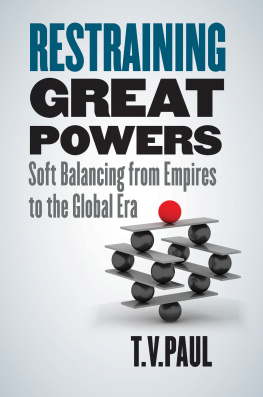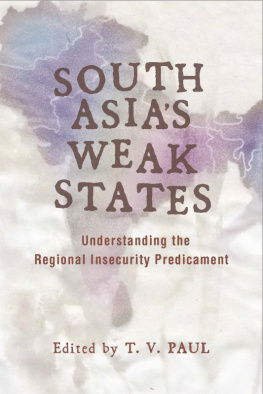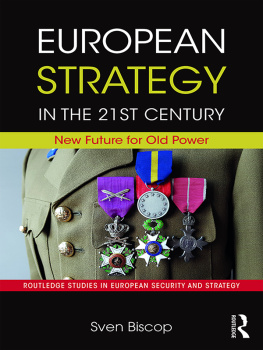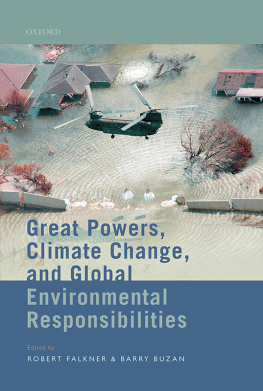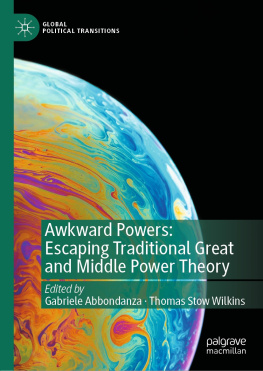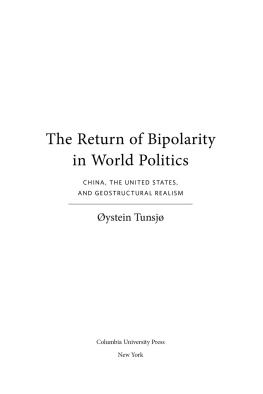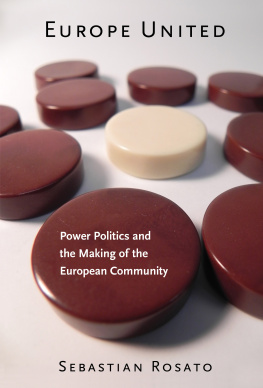Restraining
Great Powers

Published with assistance from the foundation established
in memory of Amasa Stone Mather of the Class of 1907,
Yale College.
Copyright 2018 by T.V. Paul.
All rights reserved.
This book may not be reproduced, in whole or in part,
including illustrations, in any form (beyond that copying
permitted by Sections 107 and 108 of the U.S. Copyright Law
and except by reviewers for the public press), without written
permission from the publishers.
Yale University Press books may be purchased in quantity for
educational, business, or promotional use. For information,
please e-mail (U.S. office) or
(U.K. office).
Set in Minion type by IDS Infotech Ltd.
Printed in the United States of America.
Library of Congress Control Number: 2018934742
ISBN 978-0-300-22848-9 (hardcover : alk. paper)
A catalogue record for this book is available from the British
Library.
This paper meets the requirements of ANSI/NISO Z39.48-1992
(Permanence of Paper).
10 9 8 7 6 5 4 3 2 1
Contents
Preface
B alance of power is one of the most enduring themes in international politics. Its antecedents go back to antiquity, to the classical era of warring Greek city-states, and it has been considered the bedrock of great-power stability since the seventeenth century. Yet it is also arguably the most contested concept and strategy in world politics. The pivotal question of whether it promotes peace or war has yet to be fully answered.
In this book, I argue that balance of power is not an immutable strategy, as some scholars and policy makers believe, but a concept shaped by the international politics of the day. Countries have used different techniques in different epochs to balance and restrain powerful or threatening states. It is often assumed that during much of the European imperial age, great powers balanced one another with formal alliances and arms buildups. But they also used international institutions and economic sanctions as means of soft balancing to restrain the power and threatening behavior of other states. The Concert System among European powers in the nineteenth century is a prominent example.
Soft balancing continued into the twentieth century. The League of Nations and its successor, the United Nations, became arenas of great-power contestation and balancing. During the Cold War, lesser powers under the rubric of the Non-Aligned Movement also engaged in a weak form of soft balancing against superpower dominance. Economic sanctions, often with the approval of an international institution, were used as a soft-balancing instrument to restrain or punish a threatening power. With the end of the Cold War, the traditional instruments of balancing, such as arms buildups and formal alliances, became less salient. For about two decadesapproximately from 1991 until 2010the United States as the preponderant power faced a surprising absence of balancing efforts against it. The U.S. outshone others not only in its aggregate power but also in using that power to initiate wars against secondary states in restive regions such as the Middle East. Similarly, China became the worlds second most powerful economy with rapidly growing military might and began a program of territorial expansion in the Pacific, especially in the South China Sea. But it has faced only limited balancing by the affected states. Vladimir Putins Russia has received limited hard-balancing responses, especially from the U.S. and its NATO allies, to its aggressive actions toward Ukraine and Baltic states.
All of these cases remain anomalies for balance-of-power theory. Why is this so? Is it because traditional instruments of power have become less effective than they used to be? My contention in this book is that states have increasingly relied on international institutions, limited ententes, and economic instruments to balance power and restrain threatening behavior. Military capabilities remain important, but they are not the only feasible instruments of balancing in the contemporary world. The availability of less threatening instruments allows states to resort to nonmilitary means more often than before because these instruments change the cost-benefit calculations about balancing.
This trend toward using less coercive instruments of balancing can continue only if globalization advances and states become more interconnected through economic links and improving technologies. A massive failure of globalization to bring sustained growth and prosperity, or the resurgence of expansionist or nativist nationalism in key countries, could alter this pattern and make military power once again the balancing instrument of choice. Globalization has brought greater prosperity to almost all nations, making zero-sum competition for resources less bitter than in previous eras, when European great powers fought massive wars in an effort to add to their material wealth and power. If globalization and resulting economic interdependence fail to foster sustained cooperation, competitive international politics could reemerge with a vengeance. The inauguration of Donald Trump as U.S. president in 2017 and the possibility of other right-wing leaders coming to power in Europe have brought a return of hard balancing as a topic of discussion. However, restraining the forces seeking the comeback of geopolitical competition and isolation may require greater use of soft balancing.
After the Cold War, the twin forces of globalization and global norms against aggressive territorial expansion restrained but did not prevent the U.S. from intervening in Iraq and Afghanistan. To some extent, these same forces simultaneously encouraged rising powers such as China and Russia to mellow their behavior. Since 2009 or so, however, China has actively expanded into contested waters such as the South China Sea and, increasingly, the Indian Ocean, and in most cases the responses of affected states have been less assertive than expected. India, a third rising power, is globalizing in every key dimension, especially economically, and is being quickly integrated into the global order. It has formed limited strategic ententes with the U.S., Japan, and some Southeast Asian countries such as Vietnam.
We should not assume that the United States or rising powers will never use military power or asymmetric strategies to achieve their goals. Since 2010, Russia and China have both employed military means to assert dominance in their immediate neighborhoods. The affected states have responded with limited hard balancing in addition to soft-balancing efforts. A massive economic decline or the imposition of protectionist trade barriers in key countries could reignite the competition for resources and wealth.
Prudent statecraft grows ever more important in preventing the world from sliding into intense rivalries and potential military conflicts. Balance-of-power strategies relying on traditional military means alone cannot guarantee long-term peace and stability in an interconnected world. A hybrid approach that includes both hard and soft balancing, relying on adequate defensive military capabilities to provide a deterrent, is necessary to preserve peace in the coming decades. The success of these approaches will depend heavily on how great powers, both established and rising, view the legitimacy of the international order and of our eras dominant institutions. If these institutions remain robust, with strong normative bases, peaceful power transitions can take place. Established powers can accommodate rising powers without violence through a mixture of soft- and limited hard-balancing techniques along with deep economic and diplomatic engagement.
Next page
